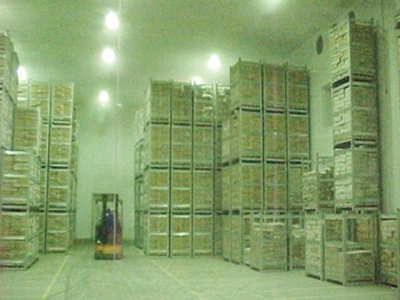How to improve poultry processing plant storage logistics

In many cold rooms, high-reach forklift trucks are used to transport and stack processed chickens.
Revising how processed chickens are moved from the line to cold storage can increase efficiency, cut ongoing costs.
Poorly considered systems for moving processed broilers into refrigeration units can have short-term and long-term effects on profitability.
High-reach forklift trucks, which are commonly used to stock today’s large-scale refrigerators, come at a cost, not only in their initial purchase, but also in terms of the need to keep an inventory of spare parts and the wear and tear that their continual use can cause to floor surfaces.
Many of these problems, however, can be reduced or solved though the installation of a bridge crane to carry out the bulk of the work, which is then supported by using standard forklift trucks.
Despite the high initial investment, installing a bridge crane in the upper reaches of the poultry processing plant can offer a number of advantages in day-to-day operations and lead long-term cost savings.
Ease of movement, greater capacity
Raising the distribution of processed broilers up off of the floor reduces the restrictions that plant layout may otherwise impose, potentially speeding up the delivery of processed birds to refrigerators.
The crane can either be operated by one person guiding it toward the refrigerators or by computer, which operates the crane once loads have been attached to it.
A bridge crane, however, will not result in forklift trucks being dispensed with; they still will be needed to support the crane. However, rather than the more expensive high-reach forklifts with retractable forks that are commonly used, standard, cheaper forklift vehicles can be employed, and these require a lower initial investment.
Using a bridge crane would require a reorganization of the refrigerated storage area, but in doing so, space can be put to better use.
Under this alternative logistics system, pallets and racks of processed birds need to be stacked only one deep against walls, and can be stacked two deep along access aisles. Because the forklifts will need to make fewer turns, as much of the work is done by a bridge crane, more aisles can be created, allowing for greater inventory to be stored and easier access.
Forklifts can still be used to lift loads as high as they are able. Once this maximum height has been reached, they simply leave any remaining product in a dedicated area for movement by the bridge crane.
Similarly, when processed chicken needs to be shipped, stacks of racks or pallets can be broken down and moved by the crane to a designated area for transport by forklifts to the waiting trucks.

Typically, in large refrigeration areas, aisles are wide to allow forklifts to be operated easily and safely.
Less need for backup
Typically, to ensure that the movement of processed chicken at the end of the processing line continues without interruption, various support materials need to be kept in store to allow a rapid response should anything go wrong with the forklifts. These reserves include replacement batteries and chargers for the forklifts, numerous spare parts, and a stock of spare tires.
Using a bridge crane and complementary fleet of simpler forklifts, however, means keeping a reduced stock of spare parts. Additionally, given that a bridge crane is a relatively simple device, fewer spare parts need to be kept in store and maintenance costs are reduced.
Lower replacement costs
Having a bridge crane move much of the load into the refrigeration area will mean that those forklifts that are still needed will be used less, and last longer. This is also important where maintenance is concerned as, for example, tires will need to be replaced less frequently. Similarly, by transporting aerially, there will be less wear and tear to, and hence need to replace, floor surfaces.

By adding a bridge crane to the transport system, time and cost can be reduced.
Có thể bạn quan tâm
 Why is methionine important for young chicks?
Why is methionine important for young chicks? Poultry feed producers today have multiple options for supplementing birds’ diets with a crystalline form of methionine (Met) including DL- methionine
 5 tips for raising healthy antibiotic-free poultry
5 tips for raising healthy antibiotic-free poultry The difficulties of antibiotic-free poultry production can be overcome by following carefully considered strategies.
 New reovirus model may lead to better prevention, control in chickens
New reovirus model may lead to better prevention, control in chickens USPOULTRY-funded research project mimics dynamics of disease transmission seen under field conditions.